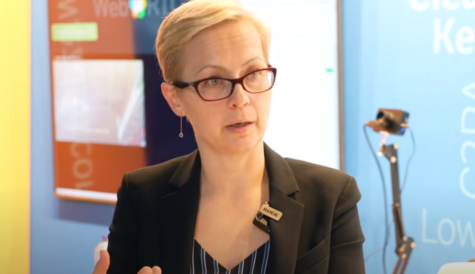
After more than 40 years of operation, DTVE is closing its doors and our website will no longer be updated daily. Thank you for all of your support.
Q&A: Boris Felts, Envivio
![]() Boris Felts, vice president of products for Envivio, talks to DTVE about the new HEVC compression standard and multiscreen video.
Boris Felts, vice president of products for Envivio, talks to DTVE about the new HEVC compression standard and multiscreen video.
 How could HEVC benefit the video distribution business in the future? What are the advantages of the technology compared with existing compression standards such as H.264 and other technologies such as MVC?
How could HEVC benefit the video distribution business in the future? What are the advantages of the technology compared with existing compression standards such as H.264 and other technologies such as MVC?
There are two main areas where the reduction of bitrate by a factor of two is critical:
• The introduction of 4K Ultra HD services
• Video distribution to new generations of smartphones and tablets for OTT services or on LTE networks
The fact that HEVC looks like it is achieving efficiency gains at least equal to those achieved by H.264 compared to MPEG-2 suggests there is more to come. To an extent, HEVC has been designed to take advantage of further improvements, not just in hardware, but in the way encoding and decoding are executed. The standard just ratified focuses on the mainstream distribution scenario, with additions to support additional specific use cases planned for 2014 and beyond. For example, while H.264 ended up with seven profiles – or sets of coding tools to meet application and device capacity requirements – in the first standard releases, HEVC has consolidated the various compression tools into three profiles. These are called:
• Main – which represents each colour with 8 bits. The 8-bit format is the most widely deployed today as it is used for video distribution and in all consumer devices.
• Main 10 – which allows 8 or 10 bits per colour. 10-bit video is used today for video contribution and is also being considered for Ultra HD due to its deeper colour depth.
• Main Still Picture – for still images transmission. Future extensions scheduled for release in January 2014 will increase the bit depth and degree of chroma sampling, as well as introducing support for both Multiview Video Coding (MVC) and Scalable Video Coding (SVC).
MVC was introduced as an extension to H.264 for encoding sequences captured simultaneously from multiple cameras in stereoscopic video. SVC, also developed as an extension to H.264, encodes at a relatively high quality bitrate that can then serve a variety of target platforms at varying resolutions.
What are likely to be the early applications for HEVC and what timeline might we expect for adoption?
We anticipate that the introduction of HEVC will be somewhat comparable to the launch of AVC, where new services used the latest standard with the newest generation of devices. We believe that first HEVC deployments are likely to be in the multi-screen and OTT worlds, but can gain benefits from HEVC including lowered CDN costs and optimised video delivery on LTE networks. However, the benefits for traditional TV services are significant and we can expect to see HEVC service rollouts in the very near future.
The home TV market with its longer deployment cycles will be driven by the deployment of 4K Ultra HD to the home, potentially through traditional broadcast or OTT services to HEVC-enabled STBs before HDTV sets with embedded HEVC decoders even exist. It is also possible that HEVC may replace existing HDTV MPEG-2 services. In addition the mobile market, with its fast replacement cycles of consumer appliances or the availability of software-based decoders represents the best potential for the development of HEVC.
Several technical factors drive that need:
• Increased size and resolution on those mobile appliances,
• Strong demand for HD video services,
• The unicast model for mobile and OTT delivery to those appliances, meaning that bandwidth is shared between end users. HEVC largely contributes to reducing the network distribution bill.
Together, these three factors call for a fast acceptance of the HEVC technology as a key-enabler.
What are the current challenges facing operators in delivering video to multiple devices such as tablets, smartphones, games consoles and smart TVs? What solutions are available?
An on-going challenge that operators face is lowering CAPEX/OPEX and the ever-evolving nature of these various ecosystems. Envivio’s converged software-based approach helps operators lower costs.
How are operators looking to monetise multiscreen services and what technology solutions are in the pipeline to help them?
There are few emerging business models in place today, ranging from rental subscription, pay per content/event, bundling in premium payTV subscription and ad-subsidised programs, (mostly catch-up TV). We are still in the early days of multiscreen monetisation. Everybody is trying to quantify how they can increase the paid subscription for this service feature, or how much money can be made from personalised ad insertion on the companion devices. Targeted ad insertion is one approach people are working on. Envivio is in trials right now with a number of MSOs to roll this out. But this is definitely a promising avenue to drive business profitability off these services.
Envivio’s Halo network media processor has ad insertion functionalities that help enable monetisation with targeted ad delivery on linear programs for any screen. Halo supports standard SCTE-35 messaging, enabling it to act on the embedded triggers used throughout the advertising workflow for live programmes.
What is Envivio planning to highlight at this year’s IBC?
We will be demonstrating our full range of solutions for Ultra HD (4K) and HEVC (H.265) compression and personalised TV Anytime services.
Our demonstrations at the show will highlight how our software-based approach can offer better video quality while optimizing bandwidth efficiency for traditional broadcast or cloud/connected TV services.
Visitors to Envivio’s booth at IBC will experience a range of advanced solutions, including:
• 4K video encoded in HEVC format with Envivio Muse transcoding software
• HEVC vs. AVC vs. MPEG-2: real-time encoding comparisons of the same video encoded in three codecs, enabling significant bitrate savings while preserving video quality
• Real-world any-screen connected TV and mobile video services offered by European customers in Belgium and Spain
• TV Anytime (nPVR, Catch-up, Start-over, and VOD) plus blackout, ad insertion, subtitling and just-in-time packaging powered by the Envivio Halo network media processor
• New approach to On-demand video production and distribution allowing to significantly lower storage and distribution costs.
Envivio will exhibit at IBC on stand 1.D73


